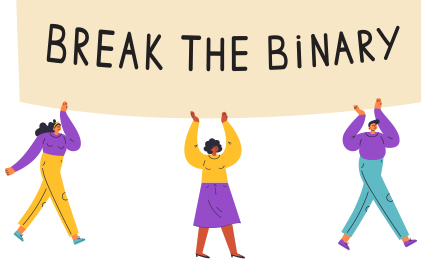Page Content

It’s important to address each other through the thoughtful use of pronouns
OUR IDENTITY PLAYS A POWERFUL ROLE in how we interact with those around us. Along with our names, we constantly refer to each other through the use of pronouns. As such, pronouns have become integral elements in defining our identity. As teachers, one of the best ways we can contribute to the comfort and acceptance of our students and colleagues, regardless of their sexual or gender identity, is to be sensitive to how we
address them. Referring to someone by the
incorrect pronoun has the same effect as calling them by the wrong name.
A MATTER OF IDENTITY
A person’s pronouns are an integral part of their identity. As author Ivan Coyote shared at the Calgary City Teachers’ Convention in February 2020, “Pronouns aren’t preferences. When I’m flying, I prefer the window seat, but I can sit in the aisle or the middle seat if I have to. I use the pronoun they. That’s the pronoun that suits me the best and that’s the one you should use.”
WHAT PRONOUNS ARE WE TALKING ABOUT?
In the English language, singular first-person pronouns (i.e. me, I, myself, mine, my) and singular second-person pronouns (i.e. you, yourself, your, yours)are not gendered. Our nonbinary students and colleagues (those who identify outside the m/f gender binary) may decide to be referred to by any of the following singular third-person pronouns:
-
he/him
-
per/per
- she/her
-
they/them
-
xe/xem
-
ze/hir
-
ze/zir
-
and many others!
Some people prefer that no pronouns are used and that they are referred to by their name only. Others may go by different sets of pronouns in different settings (such as at work versus social settings). Never assume. If you have any doubt about which pronouns to use, just ask.
INCLUSIVE PRACTICES
Sharing your own pronouns is the best way to encourage others to share theirs. By offering this information about yourself, you create a safe space where others are more likely to share their pronouns. Say something like, “Hi, I’m Dan. I go by he/him and they pronouns. How should I refer to you?”
A majority of the population will likely identify with the traditional binary pronouns (he/him and she/her) and that’s alright. By sharing your pronouns with others, you’re acknowledging that you’re sensitive to their pronoun choice and want to get it right. Don’t force anyone to share their pronouns if they don’t want to. Sharing your pronouns and inviting them to do the same is enough.
If you are organizing an event, consider providing a place on your nametags for attendees to indicate the pronoun of their choice. Stickers are now readily available that specify the various pronoun combinations. If you’re attending an event, it never hurts to be proactive and bring some sticker sheets with you to drop off at the registration desk. No matter what the situation, including your pronouns on your own nametag goes a long way.
WHAT IF I MISGENDER SOMEONE?
Everyone makes mistakes. If you have inadvertently misgendered someone,
-
apologize as soon as you can. A private, one-on-one conversation is best. A public apology in front of a group is not appropriate.
-
be accountable. Don’t try to defend your intentions or justify your mistake. Own your discomfort and be willing to listen.
-
commit to do better. Acknowledge the importance of getting their pronouns correct in the future.
RECOMMENDED RESOURCE
www.mypronouns.org
Quick tips
They/them pronouns are generally accepted as gender-neutral pronouns that can be used as a replacement for the traditional binary he/him and she/her pronoun sets in daily life and teaching.
They/them should not be used to refer to an individual who has identified other pronouns they want used. Doing so is also misgendering.
In its definition of they, the Oxford English Dictionary explains that the singular they emerged by the 14th century, about a century after the plural they. It has been commonly employed in everyday English ever since.

